 History
History  History
History  Weird Stuff
Weird Stuff 10 Everyday Products Surprisingly Made by Inmates
 Movies and TV
Movies and TV 10 Actors Dragged out of Retirement for One Key Role
 Creepy
Creepy 10 Lesser-Known Shapeshifter Legends from Around the World
 Animals
Animals 10 Amazing Animal Tales from the Ancient World
 Gaming
Gaming 10 Game Characters Everyone Hated Playing
 Books
Books 10 Famous Writers Who Were Hypocritical
 Humans
Humans 10 of the World’s Toughest Puzzles Solved in Record Time
 Mysteries
Mysteries 10 Scientific Mysteries We Don’t Fully Understand
 Weird Stuff
Weird Stuff 10 Celebrities Who Have Admitted to Alien Encounters
 History
History Ten Revealing Facts about Daily Domestic Life in the Old West
 Weird Stuff
Weird Stuff 10 Everyday Products Surprisingly Made by Inmates
 Movies and TV
Movies and TV 10 Actors Dragged out of Retirement for One Key Role
Who's Behind Listverse?

Jamie Frater
Head Editor
Jamie founded Listverse due to an insatiable desire to share fascinating, obscure, and bizarre facts. He has been a guest speaker on numerous national radio and television stations and is a five time published author.
More About Us Creepy
Creepy 10 Lesser-Known Shapeshifter Legends from Around the World
 Animals
Animals 10 Amazing Animal Tales from the Ancient World
 Gaming
Gaming 10 Game Characters Everyone Hated Playing
 Books
Books 10 Famous Writers Who Were Hypocritical
 Humans
Humans 10 of the World’s Toughest Puzzles Solved in Record Time
 Mysteries
Mysteries 10 Scientific Mysteries We Don’t Fully Understand
 Weird Stuff
Weird Stuff 10 Celebrities Who Have Admitted to Alien Encounters
10 Weird Facts About The Incredible Velvet Worm
Velvet worms are mysterious creatures with strange bodies, unexpected social interactions, and unorthodox sexual practices. They are limited to tropical regions and temperate parts of the southern hemisphere. But don’t be fooled by their cuddly name. These intriguing creatures are an animal opponent’s worst nightmare.
10 Slime Attacks
Velvet worms possess an ancient trait that seems like something out of science fiction. These creatures can spray a gluey slime up to 30 centimeters (1 ft) away to immobilize prey.
Formed inside two glands that together make up around 10 percent of the creature’s body mass, the slime is propelled through muscular contractions and then forcefully ejected through two legs adapted into openings called oral tubes. Blasted out like a sprinkler, the slime soon solidifies and traps the prey.
Once the prey is immobilized, the velvet worm consumes it. Scientists were surprised to discover that the spray is directed by the movement of fluid through the oral tubes, rather than by muscles.
As the fluid is forced through the oral tubes, these appendages flop around like a loose hose. The oscillations create the sprinkler effect required to capture prey effectively, so the velvet worm can proceed with its even more unsettling ways of consuming prey.
9 Jointless Stub Feet
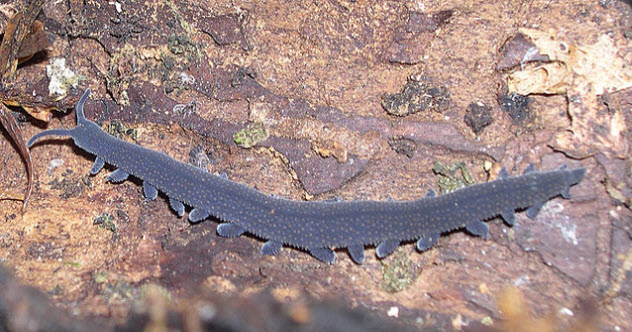
Velvet worms are intrinsically strange. Even their apparently ordinary body parts have odd adaptations. For example, rows of legs run down each side of the velvet worm’s body like a centipede. Although each leg looks typical at first, a closer examination reveals a complete absence of any joints.
Velvet worms possess “stub feet” that are simple, fluid-filled structures controlled by hydrostatic action. Their stub feet look like blobs.
These feet can be bent and compressed in different directions. The velvet worm is able to walk and support its body without a skeleton by hydrostatic means. By alternating fluid pressure, its appendages move as pairs in an upward direction as its body moves in waves. The worm’s hydrostatic locomotion is slow but effective.
The animal’s flexibility allows it to move with relative ease over a variety of surfaces in its habitat. Each leg is tipped with a slightly recessed, sharp claw, permitting the velvet worm to grip tightly as it moves on its jointless legs.
8 Impressive Fangs
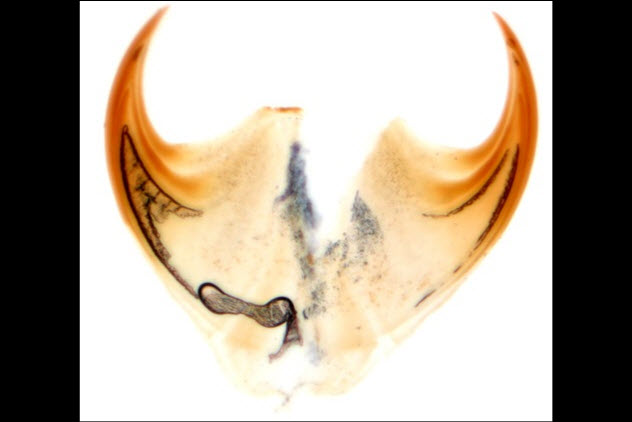
After finding a vulnerable spot on its prey, the velvet worm uses its large, curved fangs—composed of inner and outer fang sets—to rip apart its victim. Strangely, the jaws move along the body instead of being opened and closed in a pattern perpendicular to the body, as seen in arthropods.
The smooth, powerful claws are formed from chitin and strengthened by biochemical ingredients known as phenols and chinons. Their proportion of materials is uniform at the base. But the tips are reinforced with calcium, which makes them harder and more resilient to damage when subduing prey.
The inner fangs have multiple denticles, but the outer fangs have a single point. The powerful fangs are attached to strong muscles and are capable of effectively processing prey after it has been immobilized by slime.
Hidden by the soft mouthparts, the fangs could likely inflict a painful bite if a human were sufficiently careless in handling the creature. Samples have shown tanning and hardening of select portions of the jaws, together with structural patterns that contain arthropodan characteristics. Such hardening is an important adaptation for the velvet worm as it rips into the hard exoskeletons of arthropod prey.
7 Velvet Worm Sociology And Group Hunting
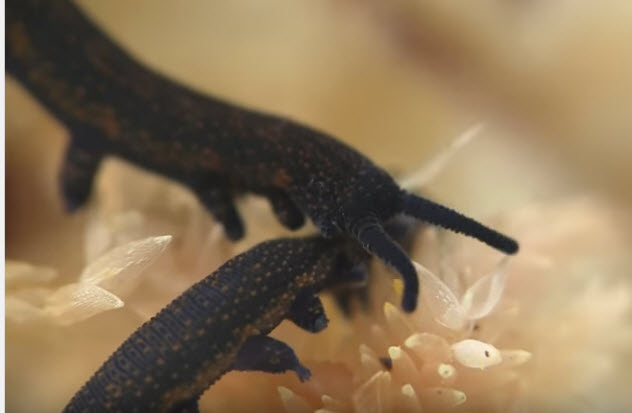
Not all velvet worms are loners. The remarkably evolved Australian species Euperipatoides rowelli is a pack hunter with a complex social organization and group hierarchy, all centered around a typically female leader. The animals forming these sophisticated organizations can trap more substantial prey through combined sliming attacks. A social order is strongly enforced, as though a pack of wolves or pride of tiny lions were at work.
The most massive, powerful worm will chase the helpers away, eating alone for a substantial time before the other members of the group get a chance to eat. The hierarchy seen in this species is rare in arthropods. The animals are believed to be related, with cooperative groups of up to 15 velvet worms exhibiting a behavior that some conservative anthropologists believe is exclusive to humans.
Yet this complex behavior is displayed in the interactions of these relatively primitive invertebrates. The combination of powerful hunting adaptations and group cooperation makes Euperipatoides rowelli, and possibly other velvet worm species, above-average predators.
6 Antenna-Based Investigation Of Prey
Using the long antennae extending from its head, the velvet worm typically investigates its potential prey with a gentle tapping or brushing on the body to determine its suitability as a meal. Nutritional value, potential danger, and size are relayed to the worm via the antennae, which are quickly withdrawn each time the prey is probed. This reduces the chance that the velvet worm will be detected by its prospective meal.
After deciding that the meal is appropriate, the velvet worm will unleash varying degrees of force, using its slime to immobilize prey before the worm’s jaws dismember and assist in the consumption of the captured animal. Slime is valuable and takes time to recharge, so checking the desirability of a meal is a cost-benefit balancing act that has proven to be worthwhile for the velvet worm.
5 Misplaced Reproductive Organs
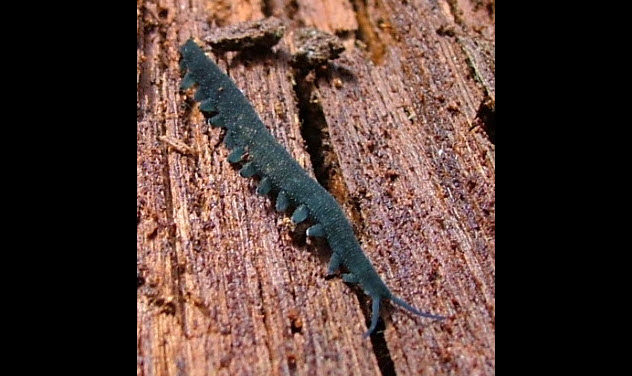
Velvet worm reproduction is as bizarre and unsettling as the way that this animal finds food. Yet the worst of the bodily damage sustained during reproduction is inflicted by a certain type of female velvet worm after interaction with a selected male.
Velvet worm males in the family Peripatopsidae will deposit sperm packets on the skin of females rather than inseminating them. The female then produces an enzyme that dissolves not only the sperm package casing but also her own skin. Through this exterior burn wound, she will absorb the sperm. After the cluster of sperm breaks apart, it will course through her bloodstream.
The transport of certain sperm may be helped by funneling structures, while other sperm go straight into sperm storage containers. Australian velvet worm expert Noel Tait of Macquarie University discovered that males of several new species had reproductive organs on their heads that were inserted into the genitals of the female.
At the same time, it appeared that skin absorption mating methods were still available if a female had already been inseminated. One velvet worm species forgoes traditional two-partner sexual reproduction altogether. Instead, this species clones itself to produce the next generation of its kind.
4 A Living Fossil Of Research Interest
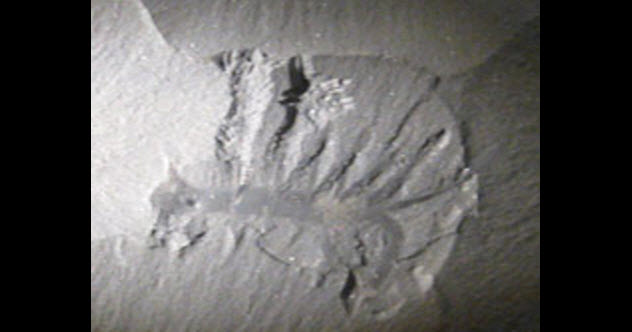
Velvet worms also have an odd evolutionary biology that fascinates scientists. With their own distinct phylum, Onychophora, velvet worms stand out as a unique form of animal life. There are 110 species, with an evolutionary history that appears to stretch back hundreds of millions of years.
Although velvet worms are now land animals, they appear to be related to marine species found in fossil records, including animals that look like the modern velvet worms that now crawl on land. Some fossils of their ancestors have been discovered with estimated ages of around 300 million years.
Their marine progenitors are even more ancient at 500 million years old. In addition to their potential marine history, velvet worms are increasingly singled out by scientists as a possible connection point in the evolutionary history of annelid worms, such as earthworms and arthropods.
Although the relationship between velvet worms, arthropods, and annelid worms is not conclusive yet, it does appear that velvet worms are actually closer to arthropods than to true worms. Notably, researchers have recently linked a strange fossil creature with legs to the velvet worm. Accounts of the discovery note that the formidable jaws of the velvet worm are actually derived from modified legs.
3 External Enzymatic Prey Digestion
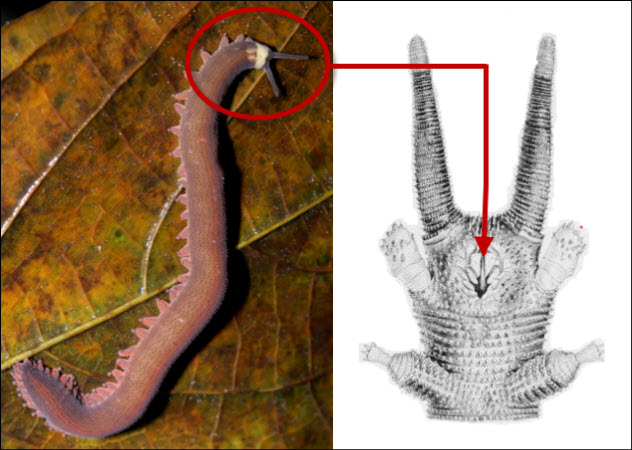
Being eaten by a velvet worm is a physically and chemically complicated fate for an animal to face and a little unsettling for a human to observe. The gross factor is partially due to the enzymatic digestion of the captured prey before it is actually consumed.
After the prey is slimed, the velvet worm uses its powerful jaws to rip the prey’s exoskeleton or skin, depending on the species captured. Next, the worm spits powerful enzymes into the body cavity of the prey through the opening ripped in the exoskeleton. The prey dissolves into a chemical soup, which the velvet worm consumes as a slurry of predigested material.
Extensive chewing or mechanical separation of edible meat from hard body parts is bypassed by this efficient method. The velvet worm also eats any of the entrapping slime sprayed onto the prey as it consumes the liquefied portion of the animal.
2 Hydrophobic Exoskeletons

Velvet worms get their name from the soft “dermal papillae” covering their skin, which bears hydrophobic (water-repellent) scales. These traits allow the worms to survive in their moist forest habitats.
Velvet worms breathe in through openings known as trachea, which are distributed across their body. These openings never close, which subjects the worms to the constant risk of drying out. As a result, they must live in environments where they can remain hydrated.
To avoid excessive water intake and moistening of the skin, velvet worms developed their characteristic covering of many fine papillae, which are comprised of tiny, overlapping scales. These scales repel excess water and allow the velvet worm to exist in the moist environment it requires without succumbing to overhydration.
1 Oxygen-Free Blood And Blood-Bathed Organs
In humans and many animal species, a primary purpose of the bloodstream is to distribute oxygen to vital organs, tissues, and cells. Velvet worms, however, do not have a typical circulatory system. They receive their oxygen through the same tubules that render them unable to retain water and make them dependent on moist environments.
The velvet worm body has no blood vessels like arteries and veins. Instead, a body cavity encloses the internal organs, which are bathed in a pool of blood. The blood—which delivers nutrients and removes waste—circulates through the body by a greatly elongated heart in the shape of a tube.
Interestingly, the velvet worm’s circulatory fluid does not transport any appreciable amount of oxygen through the body. To obtain oxygen and transfer it to the organs, the velvet worm relies on a direct delivery respiration system. Oxygen enters the body for “direct deposit” into the target organ system through spiracles, small holes in the skin that are connected to fine air tubes. In this way, the velvet worm bypasses blood for oxygen delivery.
Christopher Stephens is an environmental consultant, wildlife interpreter, and Listverse writer based in British Columbia, Canada. He completed his M.Sc. in Environment and Management and writes about health, wildlife, and business. If you are interested in his environmental consulting, writing, or nature education services, you may contact him through cmswritingconsulting.com. An experienced naturalist, Christopher also leads world-class bird-watching tours for Pacific Rain Forest Adventure Tours in British Columbia.








